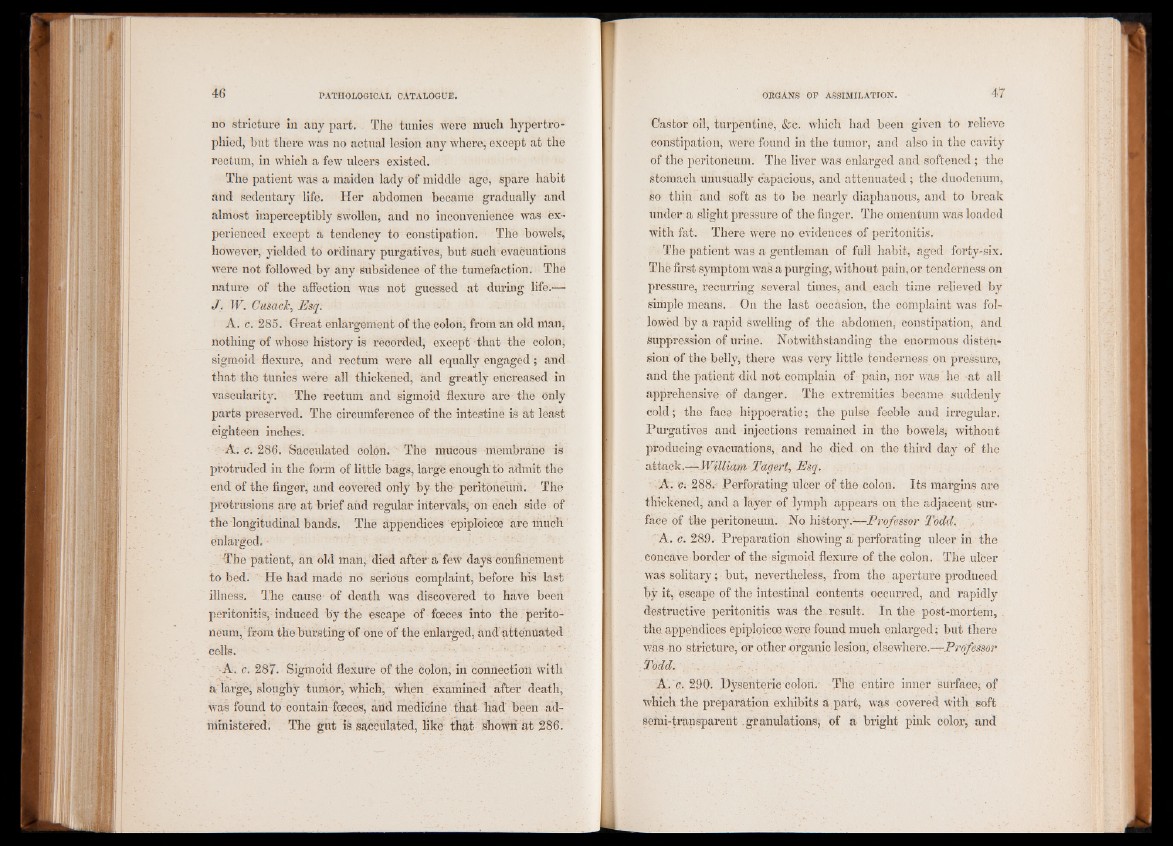
no stricture in any part. The tunics were much hypertrophied,
but there was no actual lesion any where, except at the
rectum, in which a few ulcers existed.
The patient was a maiden lady of middle age, spare habit
and sedentary life. Her abdomen became gradually and
almost imperceptibly swollen, and no inconvenience was experienced
except a tendency to constipation. The bowels,
however, yielded to ordinary purgatives, but such evacuations
were not followed by any Subsidence of the tumefaction. The
nature of the affection was not guessed at during life.—
J. W. Cusack, Esq.
A. c. 285. Great enlargement of the colon, from an old man,
nothing of whose history is reoorded, except that the colon,
sigmoid flexure, and rectum were all equally engaged; and
that the tunics were all thickened, and greatly ericreased in
vascularity. The rectum and sigmoid flexure are the only
parts preserved. The circumference of the intestine is at least
eighteen inches. ■
A. c. 286. Sacculated colon. The mucous membrane is
protruded in the form of little bags, large enough to admit the
end of the finger, and covered only by the peritoneum. The
protrusions are at brief and regular intervals, on each side of
the longitudinal bands. The appendices epiploicoe are much
enlarged.
The patient, an old man, died after a few days confinement
to bed. He had made no serious complaint, before his last
illness. The cause- of death was discovered to have beeii
peritonitis, induced by the escape of foeces into the . perito-
neum, from the bursting of one of the enlarged, and’attenuated
cells.
A. c. 287. Sigmoid flexure of the Colon, in connection with
a large, sloughy tumor, which, when examined after death,
was found to contain foeces, and medicine that had been administered.
The gut is sacculated, like that shown at 286.
Castor oil, turpentine, &c. which had been given to relieve
constipation, were found in the tumor, and also in the cavity
of the peritoneum. The liver was enlarged and softened; the
stomach unusually capacious, and attenuated ; the duodenum,
so thin and soft as to be nearly diaphanous, and to break
under a slight pressure of the finger. The omentum was loaded
with fat. There were no evidences of peritonitis.
The patient was a gentleman of full habit, aged forty-six.
The first symptom was a purging, without pain, or tenderness on
pressure, recurring several times, and each time relieved by
simple means. On the last occasion, the complaint was followed
by a rapid swelling of the abdomen, constipation, and
Suppression of urine. Notwithstanding the enormous distension
of the belly, there was very little tenderness on pressure,
and the patient' did not complain of pain, nor was he at all
apprehensive1 of danger. The extremities became suddenly
cold; the face hippocratic; the pulse feeble and irregular.
Purgatives and injections remained in the bowels* without
producing evacuations, and he died on the third day of the
attack.— William Tagert. Esq.
A. c: 288. Perforating- ulcer of the colon. Its margins are
thickened, and a layer of lymph appears on the adjacent surface
of the peritoneum. No history.1—Professor Todd.
A. c. 289. Preparation showing a perforating ulcer in the
concave border of the sigmoid flexure of the colon. The ulcer
was solitary; but, nevertheless, from the aperture produced
by it, escape of the intestinal contents occurred, and rapidly
destructive peritonitis was the result. In the post-mortem,
the appendices epiploicoe Were found much enlarged; but there
was no stricture, or other organic lesion, elsewhere.—Professor
Todd. .
A. c. 290. Dysenteric colon. The entire inner surface; of
which the preparation exhibits a part, was covered with soft
semi-transparent granulations, of a bright pink color, and